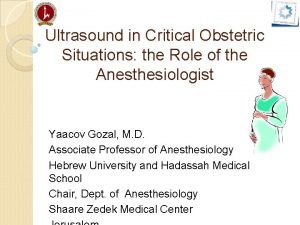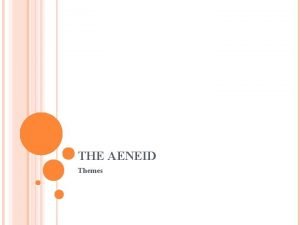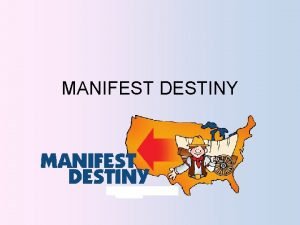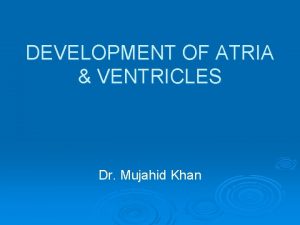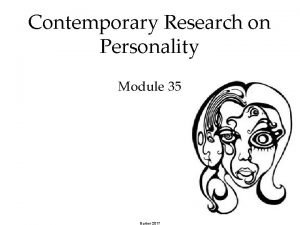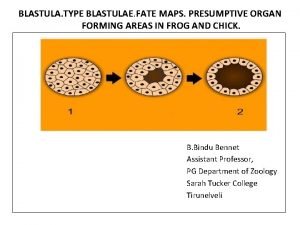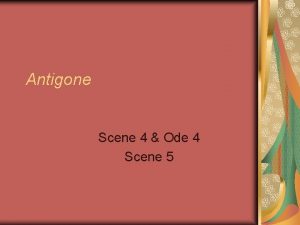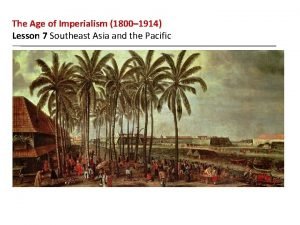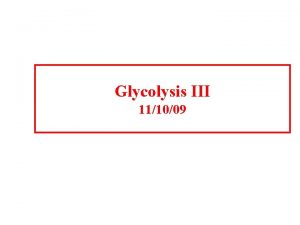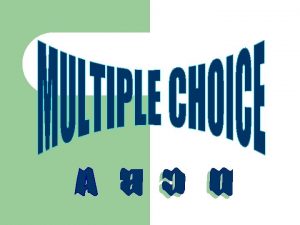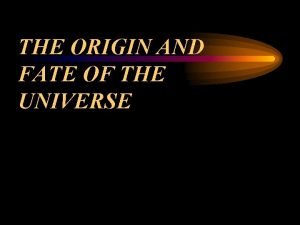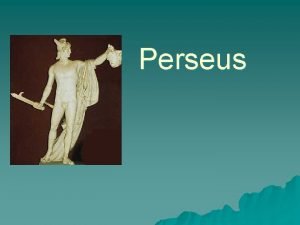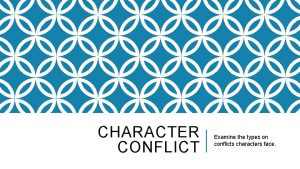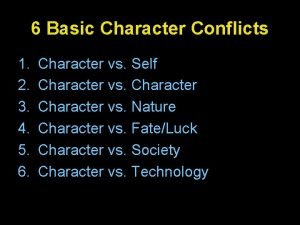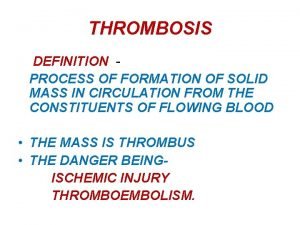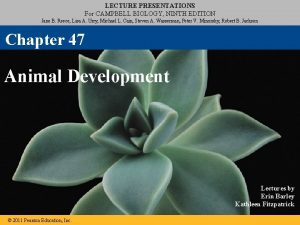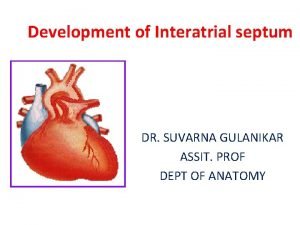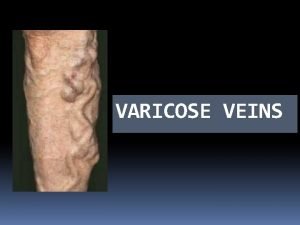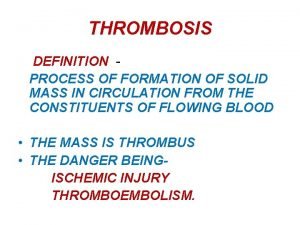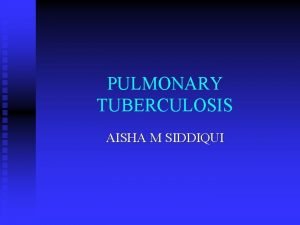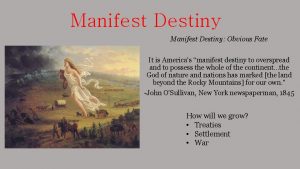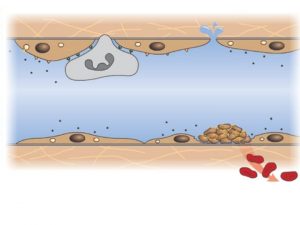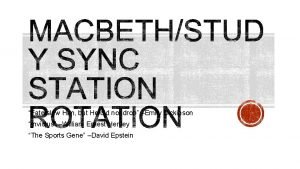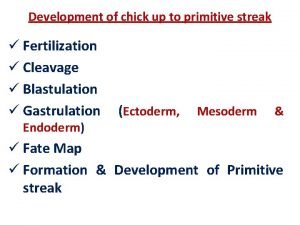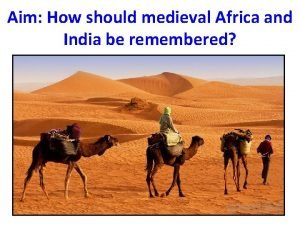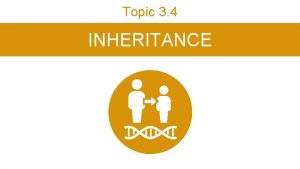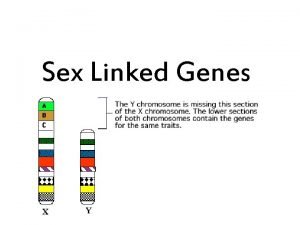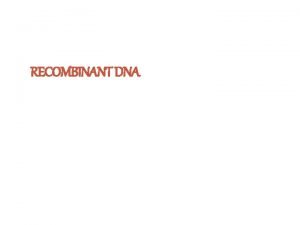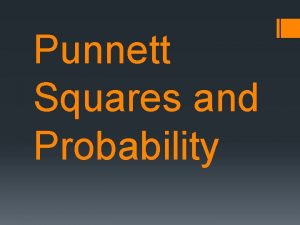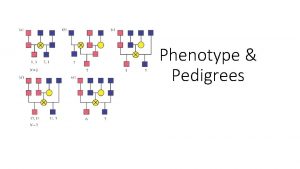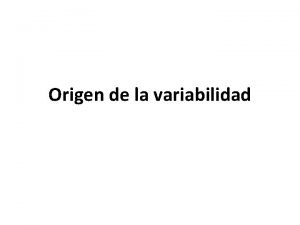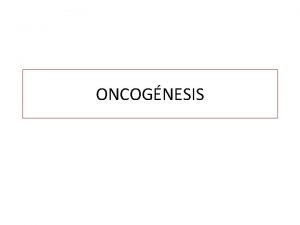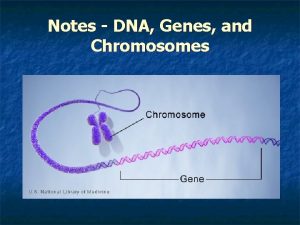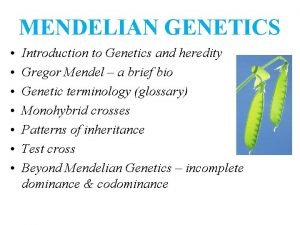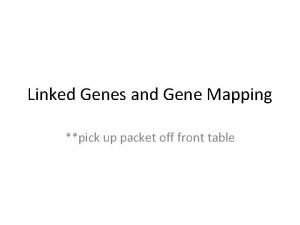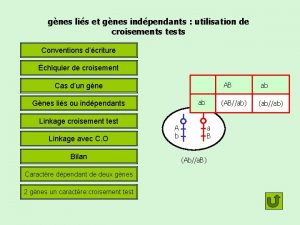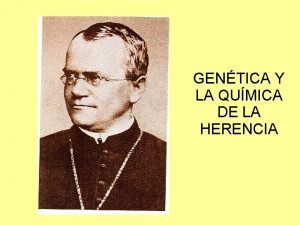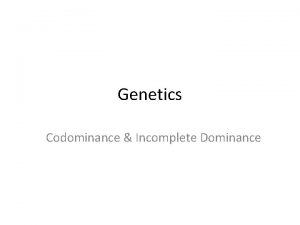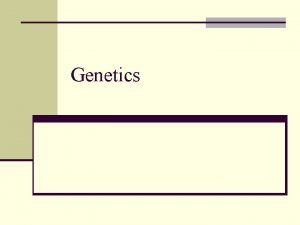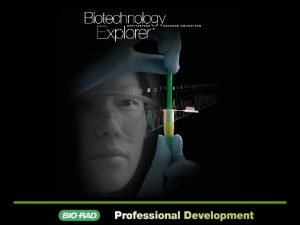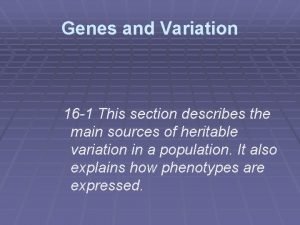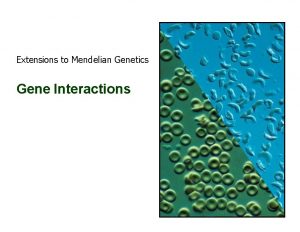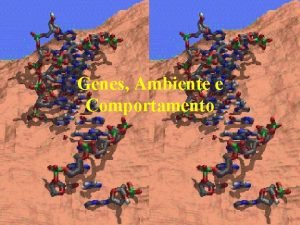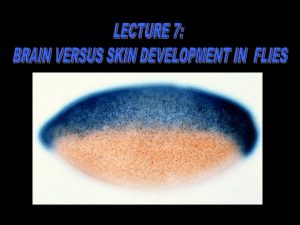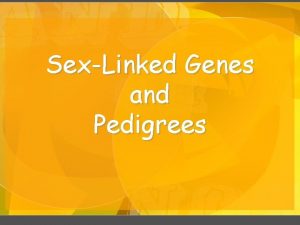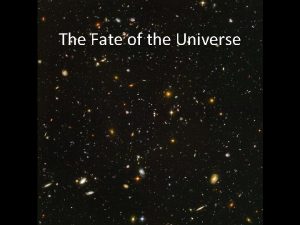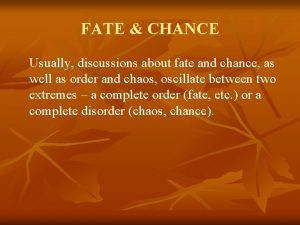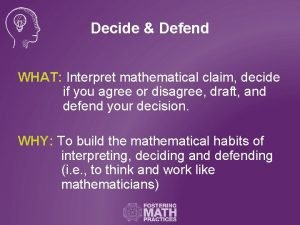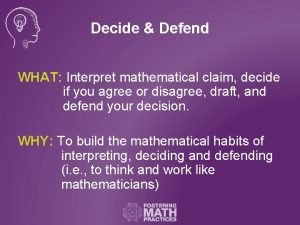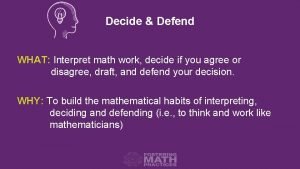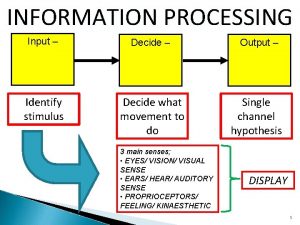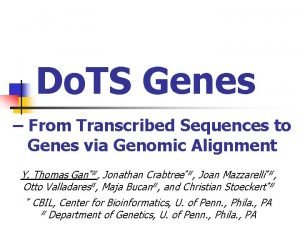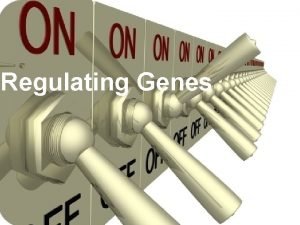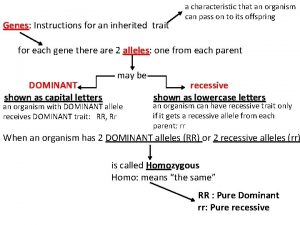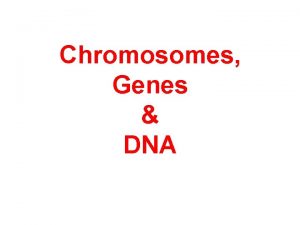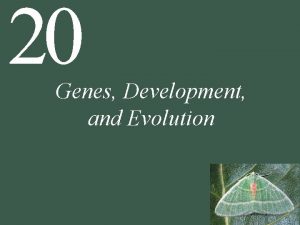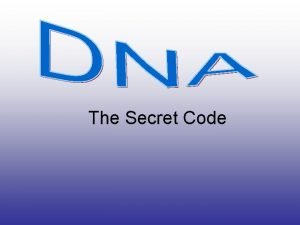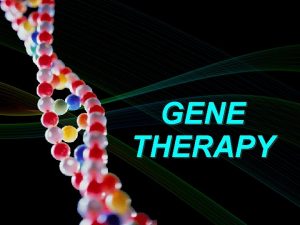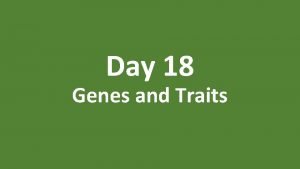Fated Do your genes decide your fate Dr



























































- Slides: 59

Fated ? Do your genes decide your fate? Dr. Katie Galloway Paradoxes August 4, 2013

Fat gene?

Infidelity gene?


Identifies-meaningless-correlations gene?

A bottom-up approach ““We are survival machines – robot vehicles blindly programmed to preserve the selfish molecules known as genes. ” – Richard Dawkins, biologist

A Reductionist view of Biology Environment & society Input: Initial conditions Molecules Networks Cells Tissues Systems Organism Output: Fate

Layers of design Environment & society Input: Initial conditions Molecules Networks Cells Tissues Systems Organism Output: Fate

Gene expression: Running genetic program Promoter: Controls production RNA from DNA p. X DNA m. RNA protein

Epigenetics and structure of DNA

Loose packing of DNA turns on genes

Tight packing of DNA turns off genes 10, 000 fold packing during cell division!

3 D structure of the genome influences how sets of genes interact

DNA wrapped for tangle free, dynamic loosing and rewrapping

Gene expression: Running the program Promoter: Controls transcription of DNA to RNA Non-coding RNA: Controls processing of m. RNA into proteins p. X DNA m. RNA protein

Percent of non-coding DNA increases with organism complexity Mattick, J. S. Scientific American 2004

“Junk DNA” is not so “junky” 98% of human non-coding DNA is translated into RNA Mattick, J. S. Scientific American 2004

Diversity of proteins 50 x > genes! ~20, 000 genes DNA m. RNA ~1, 000 proteins protein

Not the size of your genome, but how you use it DNA RNA translation Brain protein Liver protein

Natural RNA control systems intervene in gene expression to direct cellular fate DNA Posttranscriptional processing transcription pre-m. RNA editing, splicing silencing m. RNA translation Brain protein Liver protein

Enormous amount of information in RNA and proteins regulate cellular fate ~20, 000 genes DNA m. RNA ~1, 000 proteins protein

Gene expression: Running the program Promoter: Controls transcription of DNA to RNA Non-coding RNA: Controls processing of m. RNA into proteins Proteins: Provide structure, energy production, regulation, define various cell types p. X DNA m. RNA protein

Genetically identical but different p. X ………………………… Protein 1 Heart muscle cells …………… Blood cells Protein N Brain cells

Levels of gene expression define cell types …………… p. X ………………………… Protein 1 < Heart muscle cells ~ Blood cells Protein N > Brain cells

Levels of gene expression define cell types Levels of expression Protein 1 Protein N Spectrum of fate < Heart muscle cells ~ Blood cells > Brain cells

Synthetic control systems control gene expression to reprogram cell fate Figure adapted from Amabile, G. & A. Meissner (2009) Trends Mol. Med. 15: 59.

Simple model for proper protein folding Native protein structure goes to lowest energy state, process runs downhill

Multi-level control for proper protein folding Native protein structure is metastable, kinetically entrapped, guided to native fold

Important molecular control at all three levels Promoter: Controls transcription of DNA to RNA Non-coding RNA: Controls processing of m. RNA into proteins Proteins: Provide structure, energy production, regulation, define various cell types p. X DNA m. RNA protein

Layers of design Environment & society Input: Initial conditions Molecules Networks Cells Tissues Systems Organism Output: Fate

No gene is an island

A systems view of the yeast mating pathway: model cancer pathway Fast positive regulation Fast negative regulation Transcriptional regulation Figure courtesy of D. Endy. 2006

MAPK pathways: regulators of cell fate Yeast Extracellular signal Pheromone Mammalian Growth factors, cytokines, cell stress Transmembrane receptor MAPKKK MAPK Pathway response Fus 3 Mating Erk 1/2 Proliferation Differentiation Development JNK p 38 Inflammation Apoptosis Development

Implications in disease and therapeutics Stem Cells Cancer Hanahan, D. and R. A. Weinberg, The hallmarks of cancer. Cell, 2000. 100(1): p. 57 -70

Signaling = Biology’s Morse code NGF Differentiation + EGF - Proliferation Differentiation Proliferation Adapted from Santos, SD et al. Growth factor-induced MAPK network topology shapes Erk response determining PC-12 cell fate. Nat Cell Biol 2007

Complex signal processing used to direct cell fate NGF Differentiation - EGF + Proliferation Differentiation Adapted from Santos, SD et al. Growth factor-induced MAPK network topology shapes Erk response determining PC-12 cell fate. Nat Cell Biol 2007

Layers of design Environment & society Input: Initial conditions Molecules Networks Cells Tissues Systems Organism Output: Fate

Life or death in response to pro-death signal is context dependent

Coordination of homeostasis in the intestine

Coordination of multiple cell types required to prevent megadeath, disaster in the intestine

Layers of design Environment & society Input: Initial conditions Molecules Networks Cells Tissues Systems Organism Output: Fate

Stress is translated into changes in hormones, genes, and ultimately cell fate

Stress can impair the immune system, brain function

Maternal nurturing reduces stress

Layers of design Environment & society Input: Initial conditions Molecules Networks Cells Tissues Systems Organism Output: Fate

Feedback changes the nature of integrated system Environment & society Input: Initial conditions Molecules Networks Cells Tissues Systems Organism Output: Fate

Even with feedback this is still a biochemical machine Environment & society Input: Initial conditions Molecules Networks Cells Tissues Systems Organism Output: Fate

Unless there is a mind and free will Environment & society Input: Initial conditions Molecules Networks Cells Tissues Systems Organism Output: Fate Mind, Will

Modifying fate via behavior

Yet, if our hope is in our will, do we have hope? Environment & society Input: Initial conditions Molecules Networks Cells Tissues Systems Organism Output: Fate Mind, Will

Hope in free will? Yes and no. For I do not do the good I want to do, but the evil I do not want to do—this I keep on doing. -Romans 7: 19

God’s intervention, mercy and grace give hope Environment & society Input: Initial conditions Molecules Networks Cells Tissues Systems Organism Output: Fate Mind, Will God, Holy Spirit, Mercy, Grace

God’s intervention, mercy and grace give hope Environment & society Input: Initial conditions Molecules Networks Cells Tissues Systems Organism Output: Fate Mind, Will God is able and willing to help those who recognize their need And Jesus said to him, “ ‘If You can? ’ All things are possible to him who believes. ” Immediately, the boy’s father cried out and said, “I do believe; help my unbelief. ” -Mark 9: 23 -24 God, Holy Spirit, Mercy, Grace

Quick summary: layers of design Environment & society Input: Initial conditions Molecules Networks Cells Tissues Systems Organism Output: Fate

Quick Summary: more than a biochemical machine Environment & society Input: Initial conditions Molecules Networks Cells Tissues Systems Organism Output: Fate Mind, Will

Quick Summary: God designed free will & hope into our very being via our bodies, minds, and the Holy Spirit Environment & society Input: Initial conditions Molecules Networks Cells Tissues Systems Organism Output: Fate Mind, Will God, Holy Spirit, Mercy, Grace

A word of caution… Jesus answered them. “Love the Lord your God with all your heart and with all your soul and with all your mind. ’ This is the first and greatest commandment. And the second is like it: ‘Love your neighbor as yourself. ’ All the Law and the Prophets hang on these two commandments. ” -Matthew 22: 37 -40

Questions for reflection 1. Is the material world enough to account for the design I see in nature? If the material world is all that there is, am I satisfied knowing I am a biochemical machine? 2. For those that embrace the potential of life beyond materialism, is the will enough? Is the will enough to make you the person you should be? 3. Evidence for a personal, loving, merciful God? 4. In light of how important the mind is to knowing God and how important social interactions can be on influencing the brain, am I acting as lovingly as I can? Am I being as kind? As gracious? Am I forgiving? Am I avoiding anger, resolving conflict? 5. How will you allow the Holy Spirit to transform you? 6. How will you build your faith today?

Questions…?
 Linked genes and unlinked genes
Linked genes and unlinked genes Factors of 15
Factors of 15 Polygenic inheritance
Polygenic inheritance William wallace fate
William wallace fate Fate exam
Fate exam Famous lines from romeo and juliet
Famous lines from romeo and juliet Themes of the aeneid
Themes of the aeneid Manifest destiny definition
Manifest destiny definition Septum secondum
Septum secondum A psychologist who classifies an individual's personality
A psychologist who classifies an individual's personality Coeloblastula diagram
Coeloblastula diagram Who “bore the gods’ prisoning anger for his pride”?
Who “bore the gods’ prisoning anger for his pride”? Non fare ad altri ciò che non vorresti fosse fatto a te
Non fare ad altri ciò che non vorresti fosse fatto a te Contrast siam’s fate to that of burma and vietnam
Contrast siam’s fate to that of burma and vietnam Metabolic fate of pyruvate
Metabolic fate of pyruvate What is boxers ultimate fate
What is boxers ultimate fate The ultimate fate of the universe
The ultimate fate of the universe Origin fate
Origin fate King acrisius fate
King acrisius fate Maschile singolare full
Maschile singolare full Fictional character
Fictional character Character vs technology examples movies
Character vs technology examples movies Throbus
Throbus Amate i vostri nemici fate del bene a chi vi odia
Amate i vostri nemici fate del bene a chi vi odia Cortical reaction
Cortical reaction Fellowships of fate
Fellowships of fate Septum secondum
Septum secondum Pratt test varicose veins
Pratt test varicose veins Throbus
Throbus Fate of primary complex
Fate of primary complex Tragedy of fate
Tragedy of fate Obvious fate definition
Obvious fate definition Trochaic tetrameter macbeth quotes
Trochaic tetrameter macbeth quotes Saddle blood clot
Saddle blood clot Fate slew him but he did not drop
Fate slew him but he did not drop Fate of germ layers
Fate of germ layers Mansa musa fate
Mansa musa fate Hemizygous definition biology
Hemizygous definition biology Sex-linked traits examples
Sex-linked traits examples Evolution of populations section 16-1 genes and variation
Evolution of populations section 16-1 genes and variation Complementary genes example
Complementary genes example Punnet square for blood
Punnet square for blood Phenotype pedigree chart
Phenotype pedigree chart Origen de la variabilidad
Origen de la variabilidad Telomerasa
Telomerasa Genes chromosomes and dna
Genes chromosomes and dna Test cross example
Test cross example Flujo de genes ejemplos
Flujo de genes ejemplos Linked genes
Linked genes Levi genes
Levi genes How do you know if a karyotype is male or female
How do you know if a karyotype is male or female Genes located on the sex chromosomes
Genes located on the sex chromosomes échiquier de croisement gènes liés
échiquier de croisement gènes liés Cromosoma
Cromosoma Codominance
Codominance Bill nye genes worksheet answers
Bill nye genes worksheet answers Intermediate inheritance
Intermediate inheritance Genes in a bottle
Genes in a bottle Section 16-1 genes and variation
Section 16-1 genes and variation Complementary genes example
Complementary genes example




